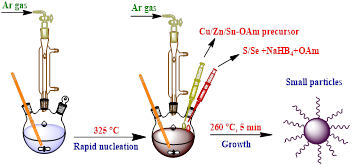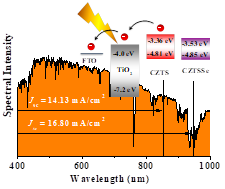Benefiting from its own superior optoelectronic properties, low cost, and solution-processable technique, quantum dot-sensitized solar cells (QDSSCs) have received increased attention for potential applications in next generation solar cells. At first, binary quantum dots were used as sensitizers. But further cell performance enhancement is limited by the narrow absorption range and single band structure of binary material. The energy level structure of multicomponent quantum dots such as ternary, quaternary ones can be continuously adjusted, through changing the element proportion or adjusting the size process. Due to the "optical bowing" effect, multicomponent materials show better photoelectric properties than binary components, favored by the majority of researchers.
Cu2ZnSnS4 (CZTS) is an excellent direct band gap semiconductor material, but its application as sensitizer in quantum dot solar cells has rarely been reported. In 2015 and 2016, it is reported by Prof. Wu Sixin’s group that CZTS QD and its core-shell structured QDs were prepared by ligand hydrolysis and cation exchange surface functionalization method, respectively. However, limited by the narrow light response range of quantum dots and harmful defects inside the material, the efficiency obtained is inferior to other high-efficiency sensitizers. Therefore, how to broaden the absorption range of CZTS material while reduce the electronic recombination is the key to realize its application in QDSC.
Based on the previous research results, Prof. Wu Sixin’s group synthesized the small-size CZTS QDs coated by oleyl amine by injecting anionic and cationic precursor solution simultaneously at high temperature with the help of the strong reducibility of NaHB4. Besides, we designed and synthesized CZTSSe QDs with adjustable band gap using Se atom with larger atomic radius to partially replace S atom. The results show that the absorption range of the QDs increases from ~ 850 nm to ~ 950 nm due to the doping of Se, which effectively widens the spectral response range and further increases short circuit current, resulting incell efficiency of 3.54%. The related work can be found in Inorg. Chem. 2019, 58, 13285-13292.

Figure 1. Schematic diagram of the typical synthesis processes of CZTSSe QDs.

Figure 2 Schematic of energy band structure and improvement of absorption range of CZTSSe QDs